Birthmark Removal Surgery
What is BIRTH-MARKS:
Brown birth marks are usually present at birth and will slowly increase in size in proportion to the individual. Flat brown birth marks can occasionally be treated with good result with the use of our Accolade or YAG laser.
PIGMENTED:
Pigmented birth marks like Nevus of Ota, Becker's Nevus, Nevus, Hairy Nevus, Cafe Au Lait etc. are usually present at birth and will slowly increase in size in proportion to the individual. Flat birth marks Nevus of Ota, becker's nevus,Cafe Au Lait etc.are occasionally treated, with good result with the use of our Accolade or Yag laser. The laser light is absorbed selectively by birth marks particles and melanin. The laser energy is converted to heat and causes mechanical destruction of the particles by photoacoustic shock wave , result is fragmentation of the target chromophore.
VASCULAR:
Abnormal vascular lesions , or birth marks like Port Wine Stain and Hemangiomas are treated with the pulse dye laser which produce a beam of yellow light that passes harmlessly through the translucent layer of the skin and specifically heats the red blood vessels causing the lesion. Because the beam is emitted in short pulses, the heat produce in the blood diffuses without damaging the surrounding tissue. After the heated blood congeals, the vessels atrophy. Thus, the laser removes or dramatically fades the marks with virtually no scarring.
The key to successful treatment is removing the birth marks as soon as possible. In infants, the marks is often lighter and less expensive therefore requiring fewer treatments. Typically 6-10 session treatment at interval of several months are required to reduce the birth mark. It is also preferable to treat patients at an early stage because the child is spares the physiological trauma and complication of growing up with a birth marks.
Most birthmarks are fairly small and are hidden by clothing however some birthmarks are on more prominent areas of the body. Some birthmarks can also pose health risks therefore some people may seek out the advice of a cosmetic surgeon with a view to getting the birthmark removed.
The key to successful birthmark removal treatment is to treat the birthmark as early as possible – in infants, the colouring is often lighter therefore fewer treatments are needed to remove the birthmark. However, older children and adults can successfully have their birthmarks removed. At a young age, normally 4-6 treatments will be needed over a period of several months. Birthmark Removal Treatment
Birthmark removal is normally done on an outpatient basis and normally does not involve an overnight stay in hospital. Lasers are usually used to remove birthmarks. A pulsed dye laser (which produces a yellow light) will be aimed at the patch of skin. The light passes harmlessly through the translucent layers of the skin and heats the underlying blood vessels that are causing the lesion.
The laser emits the light in pulses meaning that the heat in the blood is diffused without damaging the surrounding tissues. The heated blood will then congeal and the vessels will atrophy leaving a lightened colouring. The time taken for each session will depend on the size and extent of the birthmark and a session can be several minutes or several hours long.
In a single session, it is possible to see dramatic results, although several treatments will probably be needed. Overall, laser treatment can dramatically fade or remove birthmark stains with virtually no scarring.
Risks & Complications
As with any form of cosmetic surgery, there is an element of risk. As the procedure is non-invasive, the risks are smaller than with other forms of cosmetic surgery. The patient may feel a slight burning sensation when the laser hits the skin and there may be some pain in the skin. The major risks associated with birthmark removal surgery are those of scarring and infection.
The skin may also become patchy, with areas of darkened or lightened skin surrounding by spots of lighter pigmentation. However, these risks are very small and not particularly common.
A birthmark is a splotch on our skin, which can appear in a variety of colors, shapes and sizes. While some birthmarks are small and inconspicuous, others have a more prominent appearance, which can be bothersome to some, and can even lower their self-esteem. In some cases, certain types of birthmarks can become a health risk. Some birthmarks do fade or completely disappear over time, however, there are others that will never fade or go away. Birthmark removal offers a solution to people who are self-conscious about their appearance and even help reduce the possibility of health risks associated with certain moles.
With the increasing popularity of various cosmetic surgery procedures, including birthmark removal, it is important that the prospective patient research and understand different issues like what the procedure can and cannot treat, inherent risks, costs, and other factors. Keep in mind, cosmetic surgery is just that – a surgical procedure whose results cannot simply be erased. While the information contained in this website will provide you with a good introduction to birthmark removal, when considering this or any other cosmetic procedure, we recommend that you consult a qualified provider with significant experience. Some important elements you should understand regarding birthmark removal include the following:
Pigmentation-type birthmarks – These can include various types of birthmarks including moles (congenital nevi), Coffee-cream spots, and Mongolian spots. Mole is a nonspecific term for nevus, which is a pigmented skin spot. While most moles pose no health risks, some large nevi may have cancerous effects later on during one’s life. Coffee-cream spots are caused by too much pigment in the skin. They do not fade away, but do not require treatment. Mongolian spots are flat, slate blue-grey patches commonly found in children. These birthmarks usually disappear when children reach school age.
Macular stains (salmon patches) – These are very thin, light pink, flat patches of discoloration. These are usually found on babies, either on the back of their neck, or on their upper eyelids. Most of the salmon patches on the eyelids disappear during the child’s first year, while most of the ones found on the neck do not.
Vascular malformations – These are caused by abnormal development of blood vessels and are almost always present from birth. Port-wine stains, a very common birthmark, are a type of vascular malformation and can be found anywhere on the body. These can be identified as flat birthmarks that are pink-red at birth and darken to a red-purple color after several years. Port-wine stains do not fade or go away. These birthmarks may be a concern if located on the face above or around the eye because they may be associated with eye and/or brain problems.
Hemangiomas – These are lesions that develop on infants within a couple of weeks after birth. These are caused by many tiny blood vessels that are bunched together and can grow quite rapidly during the child’s first six to nine months. These are the most common tumors found in babies and usually develop around the head and neck. Some hemangioma will grow on internal organs, like the stomach, liver, intestines, or kidneys. This can be identified with discolorations in the skin. Some disappear within a few months after birth, while most take years before they disappear or fade. Please consult with a physician about these conditions.
Laser therapy: Lasers are used to treat birthmarks that are close to the surface of the skin, such as port-wine stains. This method can be performed at any age. During treatment, short bursts of laser light are aimed at the birthmark in order to shrink it or cause it to stop growing. Multiple visits may be necessary to achieve optimal results.
Laser therapy may also be used for hemangioma, however it is not used to treat cases where it is found on an internal organ, or deep within the skin.
Surgery: This method is used when other non-surgical treatments have not worked. A hemangioma that is large, or found on an internal organ also requires surgery and general anesthesia.
Note: Sometimes, medication is enough to treat certain types of birthmarks. Please consult with a physician about which method will work best for your needs.
Following treatment, it is recommended that patients do not scratch the treated area. It is also important to stay out of the sun while healing. When in the sun, patients should use sunscreen. The healing process takes about six weeks after treatment; during that time, the results of the procedure should become more evident. For children that undergo a birthmark removal, parents should make sure they follow the doctor’s post-op instructions.
Unfortunately most medical insurance providers do not cover cosmetic surgery procedures. However, most surgeons do offer multiple financing options. CosmeticSurgery.com provides information on various ways patients can fit birthmark removal into their budget.




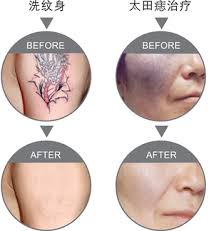

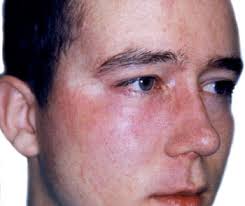





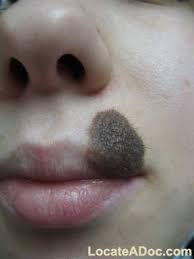

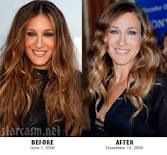
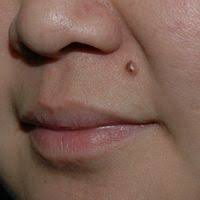
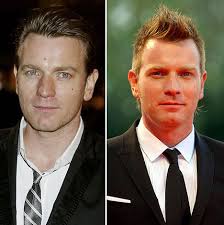
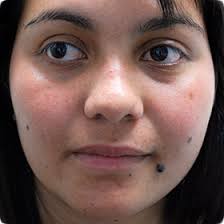


Brown birth marks are usually present at birth and will slowly increase in size in proportion to the individual. Flat brown birth marks can occasionally be treated with good result with the use of our Accolade or YAG laser.
 |  | |||
| Before | After |
PIGMENTED:
Pigmented birth marks like Nevus of Ota, Becker's Nevus, Nevus, Hairy Nevus, Cafe Au Lait etc. are usually present at birth and will slowly increase in size in proportion to the individual. Flat birth marks Nevus of Ota, becker's nevus,Cafe Au Lait etc.are occasionally treated, with good result with the use of our Accolade or Yag laser. The laser light is absorbed selectively by birth marks particles and melanin. The laser energy is converted to heat and causes mechanical destruction of the particles by photoacoustic shock wave , result is fragmentation of the target chromophore.
VASCULAR:
Abnormal vascular lesions , or birth marks like Port Wine Stain and Hemangiomas are treated with the pulse dye laser which produce a beam of yellow light that passes harmlessly through the translucent layer of the skin and specifically heats the red blood vessels causing the lesion. Because the beam is emitted in short pulses, the heat produce in the blood diffuses without damaging the surrounding tissue. After the heated blood congeals, the vessels atrophy. Thus, the laser removes or dramatically fades the marks with virtually no scarring.
The key to successful treatment is removing the birth marks as soon as possible. In infants, the marks is often lighter and less expensive therefore requiring fewer treatments. Typically 6-10 session treatment at interval of several months are required to reduce the birth mark. It is also preferable to treat patients at an early stage because the child is spares the physiological trauma and complication of growing up with a birth marks.
A guide to birthmark removal surgery
Many people are born with birthmarks and these birthmarks can vary in size, colour and location. Birthmarks are generally described as a mark on the skin that is unique to the individual that does not quickly disappear.Most birthmarks are fairly small and are hidden by clothing however some birthmarks are on more prominent areas of the body. Some birthmarks can also pose health risks therefore some people may seek out the advice of a cosmetic surgeon with a view to getting the birthmark removed.
There are three major types of birthmark:
- Vascular Birthmarks: Vascular birthmarks are one of the most common types of birthmarks and are often known as ‘port-wine stains’. They can be found on all areas of the body and typically will not fade or disappear over time.
- Macular Birthmarks: Macular birthmarks are sometimes known as salmon patches and are flat, normally light pink patches of skin. They are most commonly found on the neck and eyelids. Those on the eyelids tend to fade over time, however the marks on the neck tend not to.
- Pigmentation Birthmarks: Pigmentation birthmarks are where the skin has too much colour or pigment. Pigmentation birthmarks include some moles, or brown or cream coloured patches of skin. These marks normally fade over time.
The key to successful birthmark removal treatment is to treat the birthmark as early as possible – in infants, the colouring is often lighter therefore fewer treatments are needed to remove the birthmark. However, older children and adults can successfully have their birthmarks removed. At a young age, normally 4-6 treatments will be needed over a period of several months. Birthmark Removal Treatment
Birthmark removal is normally done on an outpatient basis and normally does not involve an overnight stay in hospital. Lasers are usually used to remove birthmarks. A pulsed dye laser (which produces a yellow light) will be aimed at the patch of skin. The light passes harmlessly through the translucent layers of the skin and heats the underlying blood vessels that are causing the lesion.
The laser emits the light in pulses meaning that the heat in the blood is diffused without damaging the surrounding tissues. The heated blood will then congeal and the vessels will atrophy leaving a lightened colouring. The time taken for each session will depend on the size and extent of the birthmark and a session can be several minutes or several hours long.
In a single session, it is possible to see dramatic results, although several treatments will probably be needed. Overall, laser treatment can dramatically fade or remove birthmark stains with virtually no scarring.
Risks & Complications
As with any form of cosmetic surgery, there is an element of risk. As the procedure is non-invasive, the risks are smaller than with other forms of cosmetic surgery. The patient may feel a slight burning sensation when the laser hits the skin and there may be some pain in the skin. The major risks associated with birthmark removal surgery are those of scarring and infection.
The skin may also become patchy, with areas of darkened or lightened skin surrounding by spots of lighter pigmentation. However, these risks are very small and not particularly common.
Laser Birthmark Removal:Birthmarks are splotches on the skin that vary in size, shape and color. They can appear anywhere on the skin, from an inconspicuous place to a location that is more prominent, such as on the face. In some cases, birthmarks can become a health risk, especially on the face or eyelids as they can be a sign of eye or brain problems.
Birthmark Removal
A birthmark is a splotch on our skin, which can appear in a variety of colors, shapes and sizes. While some birthmarks are small and inconspicuous, others have a more prominent appearance, which can be bothersome to some, and can even lower their self-esteem. In some cases, certain types of birthmarks can become a health risk. Some birthmarks do fade or completely disappear over time, however, there are others that will never fade or go away. Birthmark removal offers a solution to people who are self-conscious about their appearance and even help reduce the possibility of health risks associated with certain moles.
With the increasing popularity of various cosmetic surgery procedures, including birthmark removal, it is important that the prospective patient research and understand different issues like what the procedure can and cannot treat, inherent risks, costs, and other factors. Keep in mind, cosmetic surgery is just that – a surgical procedure whose results cannot simply be erased. While the information contained in this website will provide you with a good introduction to birthmark removal, when considering this or any other cosmetic procedure, we recommend that you consult a qualified provider with significant experience. Some important elements you should understand regarding birthmark removal include the following:
Types of Birthmarks
Before determining how to remove these birthmarks, here is some information on the more common types and how to identify them:Pigmentation-type birthmarks – These can include various types of birthmarks including moles (congenital nevi), Coffee-cream spots, and Mongolian spots. Mole is a nonspecific term for nevus, which is a pigmented skin spot. While most moles pose no health risks, some large nevi may have cancerous effects later on during one’s life. Coffee-cream spots are caused by too much pigment in the skin. They do not fade away, but do not require treatment. Mongolian spots are flat, slate blue-grey patches commonly found in children. These birthmarks usually disappear when children reach school age.
Macular stains (salmon patches) – These are very thin, light pink, flat patches of discoloration. These are usually found on babies, either on the back of their neck, or on their upper eyelids. Most of the salmon patches on the eyelids disappear during the child’s first year, while most of the ones found on the neck do not.
Vascular malformations – These are caused by abnormal development of blood vessels and are almost always present from birth. Port-wine stains, a very common birthmark, are a type of vascular malformation and can be found anywhere on the body. These can be identified as flat birthmarks that are pink-red at birth and darken to a red-purple color after several years. Port-wine stains do not fade or go away. These birthmarks may be a concern if located on the face above or around the eye because they may be associated with eye and/or brain problems.
Hemangiomas – These are lesions that develop on infants within a couple of weeks after birth. These are caused by many tiny blood vessels that are bunched together and can grow quite rapidly during the child’s first six to nine months. These are the most common tumors found in babies and usually develop around the head and neck. Some hemangioma will grow on internal organs, like the stomach, liver, intestines, or kidneys. This can be identified with discolorations in the skin. Some disappear within a few months after birth, while most take years before they disappear or fade. Please consult with a physician about these conditions.
Who would best represent an Ideal Candidate for Birthmark Removal?
People who feel their birthmarks may cause risks to their health constitute as qualified candidates for the procedure, as would those who are bothered by the appearance of birthmarks. Undergoing birthmark removal can help enhance one’s appearance and possibly provide a boost to one’s self-esteem. However, one must remember that cosmetic surgery is meant for improvement, not perfection. It is important to have realistic goals and expectations when considering birthmark removal.How is Birthmark Removal Performed?
There are different ways that a birthmark can be removed, depending upon its type, size, location and other factors.Laser therapy: Lasers are used to treat birthmarks that are close to the surface of the skin, such as port-wine stains. This method can be performed at any age. During treatment, short bursts of laser light are aimed at the birthmark in order to shrink it or cause it to stop growing. Multiple visits may be necessary to achieve optimal results.
Laser therapy may also be used for hemangioma, however it is not used to treat cases where it is found on an internal organ, or deep within the skin.
Surgery: This method is used when other non-surgical treatments have not worked. A hemangioma that is large, or found on an internal organ also requires surgery and general anesthesia.
Note: Sometimes, medication is enough to treat certain types of birthmarks. Please consult with a physician about which method will work best for your needs.
How Much Pain is Associated with Birthmark Removal?
This depends upon the type of procedure used. For laser therapy, patients may feel mild pain, like a rubber band snapping at the skin. Some experience a transient, mild burning sensation. An anesthetic may be given to those people sensitive to pain.What should be expected after undergoing Birthmark Removal?
After undergoing laser therapy, the treated skin becomes dark purple. This should only last about seven to ten days and disappear soon after. However in some cases, it can take six to eight weeks for the purple area to completely disappear.Following treatment, it is recommended that patients do not scratch the treated area. It is also important to stay out of the sun while healing. When in the sun, patients should use sunscreen. The healing process takes about six weeks after treatment; during that time, the results of the procedure should become more evident. For children that undergo a birthmark removal, parents should make sure they follow the doctor’s post-op instructions.
What Are the Risks of Birthmark Removal?
Surgical removal of birthmarks carries the same risks associated with any surgical procedure. This includes bleeding, infection and scarring. If a scar is left, other treatments like skin grafts may be used to correct this condition. This also applies to large hemangiomas removed from the body. If general anesthesia is used, an allergic reaction to the anesthesia is also a risk.What Are The Typical Costs Associated With Birthmark Removal?
The costs for birthmark removal vary depending on the method used and the size of the area to be treated. Estimated costs for birthmark removal can range anywhere from $400-500. Fees within various regions may also vary depending on whether the doctor’s practice is in an urban, suburban or rural area. When viewing costs for birthmark removal, make sure the total figure includes any and all associated costs. A comprehensive cost figure may be obtained while consulting with a cosmetic surgeon or dermatologist.Unfortunately most medical insurance providers do not cover cosmetic surgery procedures. However, most surgeons do offer multiple financing options. CosmeticSurgery.com provides information on various ways patients can fit birthmark removal into their budget.






0 comments:
Post a Comment